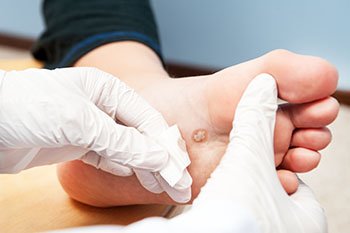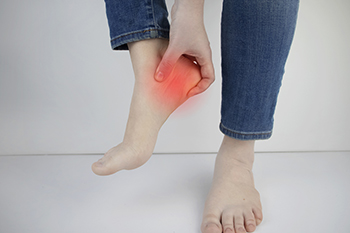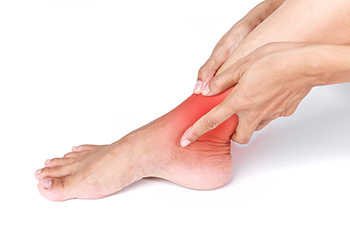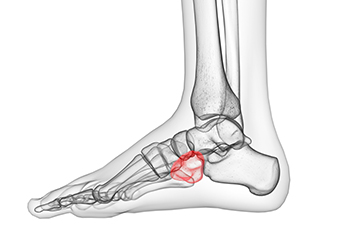Items filtered by date: May 2022
What Does a Plantar Wart Look Like?

The human papillomavirus (HPV) is responsible for the development of plantar warts. It is defined as a wart that forms on the bottom of the foot, and grows inward as a result of the weight the feet bear on a daily basis. They are contagious, and this particular virus lives in warm and moist environments which can include public swimming pools, shower room floors, and locker rooms. It is beneficial to wear appropriate shoes while in these areas, and to refrain from sharing towels, shoes, and socks. This may help to prevent the spread of HPV. Plantar warts appear as small hardened areas of skin with tiny black dots in the center, and can cause severe pain and discomfort. Plantar warts can make it difficult to walk, and it is suggested that you consult a podiatrist who can properly treat or remove this type of wart.
Plantar warts can be very uncomfortable. If you need your feet checked, contact Gary Cockrell, DPM from Tennessee. Our doctor will assist you with all of your foot and ankle needs.
About Plantar Warts
Plantar warts are the result of HPV, or human papillomavirus, getting into open wounds on the feet. They are mostly found on the heels or balls of the feet.
While plantar warts are generally harmless, those experiencing excessive pain or those suffering from diabetes or a compromised immune system require immediate medical care. Plantar warts are easily diagnosed, usually through scraping off a bit of rough skin or by getting a biopsy.
Symptoms
- Lesions on the bottom of your feet, usually rough and grainy
- Hard or thick callused spots
- Wart seeds, which are small clotted blood vessels that look like little black spots
- Pain, discomfort, or tenderness of your feet when walking or standing
Treatment
- Freezing
- Electric tool removal
- Laser Treatment
- Topical Creams (prescription only)
- Over-the-counter medications
To help prevent developing plantar warts, avoid walking barefoot over abrasive surfaces that can cause cuts or wounds for HPV to get into. Avoiding direct contact with other warts, as well as not picking or rubbing existing warts, can help prevent the further spread of plantar warts. However, if you think you have developed plantar warts, speak to your podiatrist. He or she can diagnose the warts on your feet and recommend the appropriate treatment options.
If you have any questions please feel free to contact our offices located in Brentwood and Madison, TN . We offer the newest diagnostic and treatment technologies for all your foot and ankle needs.
The Heel of My Foot Hurts!

Many people complain about pain in the heel of their foot at some point in their lives. Plantar fasciitis, or inflammation of the plantar fascia, is one of the most common causes of this. The plantar fascia is the broad band of connective tissue running along the bottom of the foot that joins the heel bone to the toes, provides support for the arch of the foot, acts as a shock absorber, and bears the body’s weight. Plantar fasciitis develops when this band of tissue becomes irritated, torn, or inflamed. This condition can be extremely painful, especially with the day’s first steps. The pain at the bottom of the heel, and sometimes the midfoot area, can be sharp and stabbing or dull and achy. Once a person starts walking, the pain usually reduces but it may come on again after prolonged periods on one’s feet or when standing after sitting for a while. While causes of plantar fasciitis are not clear, research shows that heel spurs can result from plantar fasciitis, which can cause pain. This ailment is common among athletes, those who are on their feet a lot, and those who are obese. If you are suffering with heel pain, it is suggested you see a podiatrist who can make a proper diagnosis and lead you in treatment.
Plantar fasciitis can be very painful and inconvenient. If you are experiencing heel pain or symptoms of plantar fasciitis, contact Gary Cockrell, DPM from Tennessee. Our doctor can provide the care you need to keep you pain-free and on your feet.
What Is Plantar Fasciitis?
Plantar fasciitis is the inflammation of the thick band of tissue that runs along the bottom of your foot, known as the plantar fascia, and causes mild to severe heel pain.
What Causes Plantar Fasciitis?
- Excessive running
- Non-supportive shoes
- Overpronation
- Repeated stretching and tearing of the plantar fascia
How Can It Be Treated?
- Conservative measures – anti-inflammatories, ice packs, stretching exercises, physical therapy, orthotic devices
- Shockwave therapy – sound waves are sent to the affected area to facilitate healing and are usually used for chronic cases of plantar fasciitis
- Surgery – usually only used as a last resort when all else fails. The plantar fascia can be surgically detached from the heel
While very treatable, plantar fasciitis is definitely not something that should be ignored. Especially in severe cases, speaking to your doctor right away is highly recommended to avoid complications and severe heel pain. Your podiatrist can work with you to provide the appropriate treatment options tailored to your condition.
If you have any questions please feel free to contact our offices located in Brentwood and Madison, TN . We offer the newest diagnostic and treatment technologies for all your foot and ankle needs.
Are You Suffering From Ingrown Toenails?
What Can a Podiatrist Help Me With?

Whether you have a temporary problem like athlete’s foot, a chronic condition like bunions, or a sprained ankle, if it affects your toes, feet, or ankles, a podiatrist is the right person to see. Podiatrists are doctors who are specifically trained to examine, diagnose, and treat a great many such problems. The following are reasons to make an appointment with a podiatrist: Foot or ankle pain from a sprain, strain, or fracture. Itchy feet that have developed blisters and perhaps cracked skin between the toes may probably have athlete’s foot. Blisters that are extremely painful and may be infected. Joint pain in the foot and ankle, especially if it impedes standing or walking. Diabetes is a major contributor to foot and ankle conditions that may threaten your limb or life, including peripheral neuropathy (numbness) and peripheral artery disease (blocking the flow of blood to the foot). Heel pain, of which plantar fasciitis is the most common, especially for athletes and people who stand for long periods of time. An ingrown toenail is a temporary problem that can become a major problem if ignored. A bunion occurs as a protruding bone that changes the alignment of your feet and becomes extremely painful. Corns and calluses cause thickened skin and usually develop from improper footwear that becomes painful. Broken bones, stress fractures, sprains, and strains of muscles, tendons, and ligaments in the foot and ankle. If any of these conditions are causing you pain or discomfort, please see a podiatrist.
If you are dealing with pain in your feet and ankles, you may want to seek help from a podiatrist. Feel free to contact Gary Cockrell, DPM from Tennessee. Our doctor can provide the care you need to keep you pain-free and on your feet.
What Is a Podiatrist?
A podiatrist is a doctor of podiatric medicine who diagnoses and treats conditions of the foot, ankle, and related structures of the leg. Your podiatrist may specialize in a certain field such as sports medicine, wound care, pediatrics, and diabetic care. Podiatrists have the ability to become board certified through training, clinical experience, and then taking an exam.
What Do Podiatrists Do?
On a daily basis, a podiatrist may perform the following activities:
- Diagnose foot ailments such as ulcers, tumors, fractures, etc.
- Use innovative methods to treat conditions
- Use corrective orthotics, casts, and strappings to correct deformities
- Correct walking patterns and balance
- Provide individual consultations to patients
It is very important that you take care of your feet. It’s easy to take having healthy feet for granted, however foot problems tend to be among the most common health conditions. Podiatrists can help diagnose and treat a variety of feet related conditions, so it is crucial that you visit one if you need assistance.
If you have any questions please feel free to contact our offices located in Brentwood and Madison, TN . We offer the newest diagnostic and treatment technologies for all your foot and ankle needs.
Is Arthritis Causing My Ankle Pain?

You may have pain in the ankle joint, where the shinbone or tibia rests on the top foot bone or talus. If you have arthritis in this joint, you will often experience pain, swelling, stiffness, and difficulty walking or moving your ankle freely. This type of arthritis may develop from an old injury, like a previous fracture, or rheumatoid arthritis (RA). If you have arthritis in your ankle, you might benefit from resting your ankle, or exercising in ways that put less stress on the ankle, like swimming or cycling. Because there are many possible reasons for ankle pain, visiting a podiatrist for an evaluation is suggested. A podiatrist will examine your feet and legs, observe your walking, check the pattern of wear on your shoes, and/or perform imaging tests.
Ankle pain can be caused by a number of problems and may be potentially serious. If you have ankle pain, consult with Gary Cockrell, DPM from Tennessee. Our doctor will assess your condition and provide you with quality foot and ankle treatment.
Ankle pain is any condition that causes pain in the ankle. Due to the fact that the ankle consists of tendons, muscles, bones, and ligaments, ankle pain can come from a number of different conditions.
Causes
The most common causes of ankle pain include:
- Types of arthritis (rheumatoid, osteoarthritis, and gout)
- Ankle sprains
- Broken ankles
- Achilles tendinitis
- Achilles tendon rupture
- Stress fractures
- Bursitis
- Tarsal tunnel syndrome
- Plantar fasciitis
Symptoms
Symptoms of ankle injury vary based upon the condition. Pain may include general pain and discomfort, swelling, aching, redness, bruising, burning or stabbing sensations, and/or loss of sensation.
Diagnosis
Due to the wide variety of potential causes of ankle pain, podiatrists will utilize a number of different methods to properly diagnose ankle pain. This can include asking for personal and family medical histories and of any recent injuries. Further diagnosis may include sensation tests, a physical examination, and potentially x-rays or other imaging tests.
Treatment
Just as the range of causes varies widely, so do treatments. Some more common treatments are rest, ice packs, keeping pressure off the foot, orthotics and braces, medication for inflammation and pain, and surgery.
If you have any questions, please feel free to contact our offices located in Brentwood and Madison, TN . We offer the newest diagnostic and treatment technologies for all your foot care needs.
Ballet Dancers and Cuboid Syndrome

The outside of the foot is generally where the pain is felt when cuboid syndrome exists. It is often misdiagnosed, and this can happen from the gradual onset of this condition. It is known to be a common ailment among ballet dancers and happens when the ligaments and joints surrounding the cuboid bone get injured. One of the first symptoms of cuboid syndrome consists of sharp pain underneath the pinky toe. Additional symptoms can include red skin around the injured area, and it may be difficult to move or twist the ankle. Research has shown it may be necessary to move the bone back into its original place, followed by taping the foot. Mild relief may be felt when the affected foot is elevated, and this may help to reduce some of the swelling. Many patients can return to their chosen activity that caused the syndrome after several weeks after the healing process has been completed. If you have injured your foot, please consult with a podiatrist who can properly diagnose and treat cuboid syndrome.
Cuboid syndrome, also known as cuboid subluxation, occurs when the joints and ligaments near the cuboid bone in the foot become torn. If you have cuboid syndrome, consult with Gary Cockrell, DPM from Tennessee. Our doctor will assess your condition and provide you with quality foot and ankle treatment.
Cuboid syndrome is a common cause of lateral foot pain, which is pain on the outside of the foot. The condition may happen suddenly due to an ankle sprain, or it may develop slowly overtime from repetitive tension through the bone and surrounding structures.
Causes
The most common causes of cuboid syndrome include:
- Injury – The most common cause of this ailment is an ankle sprain.
- Repetitive Strain – Tension placed through the peroneus longus muscle from repetitive activities such as jumping and running may cause excessive traction on the bone causing it to sublux.
- Altered Foot Biomechanics – Most people suffering from cuboid subluxation have flat feet.
Symptoms
A common symptom of cuboid syndrome is pain along the outside of the foot which can be felt in the ankle and toes. This pain may create walking difficulties and may cause those with the condition to walk with a limp.
Diagnosis
Diagnosis of cuboid syndrome is often difficult, and it is often misdiagnosed. X-rays, MRIs and CT scans often fail to properly show the cuboid subluxation. Although there isn’t a specific test used to diagnose cuboid syndrome, your podiatrist will usually check if pain is felt while pressing firmly on the cuboid bone of your foot.
Treatment
Just as the range of causes varies widely, so do treatments. Some more common treatments are ice therapy, rest, exercise, taping, and orthotics.
If you have any questions, please feel free to contact our offices located in Brentwood and Madison, TN . We offer the newest diagnostic and treatment technologies for all your foot care needs.

